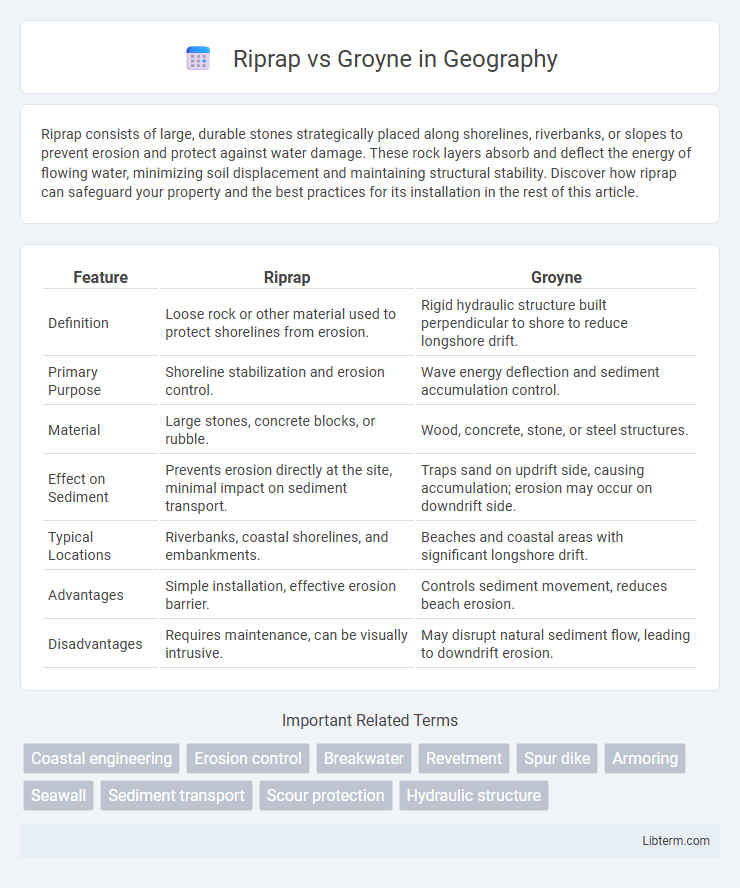Riprap consists of large, durable stones strategically placed along shorelines, riverbanks, or slopes to prevent erosion and protect against water damage. These rock layers absorb and deflect the energy of flowing water, minimizing soil displacement and maintaining structural stability. Discover how riprap can safeguard your property and the best practices for its installation in the rest of this article.
Table of Comparison
| Feature | Riprap | Groyne |
|---|---|---|
| Definition | Loose rock or other material used to protect shorelines from erosion. | Rigid hydraulic structure built perpendicular to shore to reduce longshore drift. |
| Primary Purpose | Shoreline stabilization and erosion control. | Wave energy deflection and sediment accumulation control. |
| Material | Large stones, concrete blocks, or rubble. | Wood, concrete, stone, or steel structures. |
| Effect on Sediment | Prevents erosion directly at the site, minimal impact on sediment transport. | Traps sand on updrift side, causing accumulation; erosion may occur on downdrift side. |
| Typical Locations | Riverbanks, coastal shorelines, and embankments. | Beaches and coastal areas with significant longshore drift. |
| Advantages | Simple installation, effective erosion barrier. | Controls sediment movement, reduces beach erosion. |
| Disadvantages | Requires maintenance, can be visually intrusive. | May disrupt natural sediment flow, leading to downdrift erosion. |
Introduction to Riprap and Groyne
Riprap consists of large, angular stones placed along shorelines or riverbanks to prevent erosion by dissipating wave energy and stabilizing soil. Groynes are rigid hydraulic structures built perpendicular to the coastline, designed to interrupt water flow and sand movement, thus accumulating sediment on one side and protecting the shore. Both methods play crucial roles in coastal and riverbank management, with riprap emphasizing erosion control through mass and groynes focusing on sediment retention and shoreline stabilization.
Definition and Key Functions
Riprap consists of large, angular stones placed along shorelines or riverbanks to prevent erosion by absorbing and deflecting water energy. Groynes are rigid, linear structures extending from the shore into the water, designed to interrupt sediment transport and accumulate sand to maintain beach stability. Both serve coastal protection but address erosion through different mechanisms: riprap stabilizes surfaces, while groynes control sediment flow.
Materials Used in Riprap and Groyne Construction
Riprap construction primarily utilizes large, angular stones or concrete rubble to create a durable, erosion-resistant barrier along shorelines and riverbanks. Groynes are typically built with wood, concrete, or rock, designed to interrupt water flow and trap sediment. The choice of materials in riprap emphasizes weight and resistance to displacement, while groynes focus on structural stability and sediment accumulation effects.
Installation Methods and Processes
Riprap installation involves placing large, angular stones or concrete pieces along shorelines or slopes, typically laid over geotextile fabric to prevent erosion and stabilize soil. This process requires proper grading of the area, positioning of armor stones, and backfilling with smaller stones or gravel to fill voids, ensuring durability against wave action. Groyne construction includes driving piles or building up stone and concrete barriers perpendicular to the shoreline, often using cofferdams or dewatering techniques to create a dry work area for secure placement and anchoring into the seabed or riverbed, focusing on interrupting sediment flow and promoting deposition.
Structural Design Differences
Riprap consists of large, loose stones placed along shorelines or riverbanks to absorb and dissipate wave energy, providing flexible erosion control without fixed structural elements. Groynes are rigid, linear structures extending perpendicular from the shore designed to interrupt sediment transport and shore currents, often constructed from timber, concrete, or rock, emphasizing stability and sediment accumulation. Structural design differences center on riprap's adaptive, permeable layers contrasted with groynes' solid, continuous barriers engineered to alter coastal sediment dynamics systematically.
Advantages of Riprap
Riprap offers superior erosion control by absorbing and deflecting wave energy effectively, making it ideal for protecting shorelines and riverbanks. Its porous structure facilitates natural water drainage, reducing hydraulic pressure and minimizing soil displacement. Compared to groynes, riprap requires less maintenance and adapts more flexibly to irregular shore contours, enhancing overall shoreline stability.
Benefits of Groynes
Groynes effectively reduce coastal erosion by interrupting longshore drift and trapping sand, leading to beach stabilization and expansion. They enhance shoreline protection by dissipating wave energy and creating calm water zones, which benefit marine habitats and recreational activities. Groynes also support coastal infrastructure by maintaining beach width, reducing the risk of flood damage.
Environmental Impact Comparison
Riprap stabilizes shorelines by placing large stones to prevent erosion, often causing minimal disruption to aquatic habitats and promoting natural sediment deposition. Groynes, built perpendicular to the shore, trap sediments and can lead to downdrift erosion, significantly altering coastal processes and affecting marine ecosystems. Environmental assessments reveal riprap tends to maintain ecological balance better, while groynes may require ongoing management to mitigate habitat loss and changes in sediment dynamics.
Cost Analysis: Riprap vs Groyne
Riprap installation typically incurs lower initial costs due to simpler materials and labor compared to groynes, which require more complex engineering and construction. Maintenance expenses for riprap are also generally less, as it involves periodic placement of stones to counter erosion, whereas groynes demand regular structural inspections and repairs due to their impact on sediment flow. Long-term cost efficiency favors riprap in areas with moderate wave energy, while groynes may justify higher costs in managing extensive shoreline stabilization and sediment accumulation.
Choosing the Right Solution for Shoreline Protection
Riprap consists of large, irregularly shaped rocks placed along shorelines to absorb and deflect wave energy, making it ideal for areas with moderate erosion and where a natural appearance is desired. Groynes are rigid, linear structures built perpendicular to the shore, designed to trap sediment and prevent longshore drift, which is effective in maintaining beach width but can cause downdrift erosion. Selecting between riprap and groynes depends on site-specific factors such as wave energy, sediment transport dynamics, environmental impact, and long-term maintenance requirements.
Riprap Infographic

 libterm.com
libterm.com